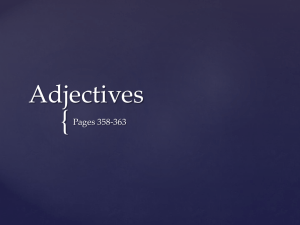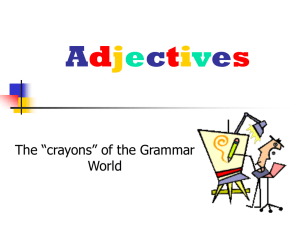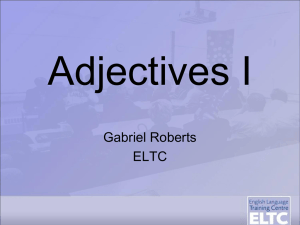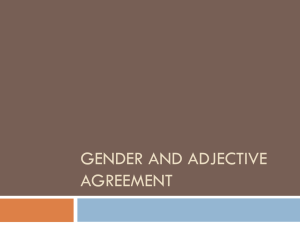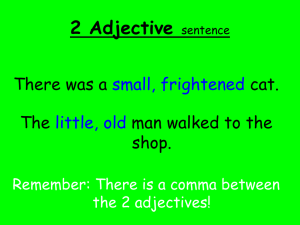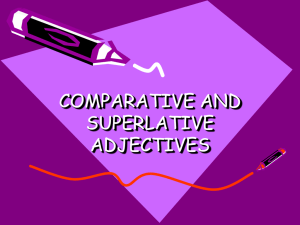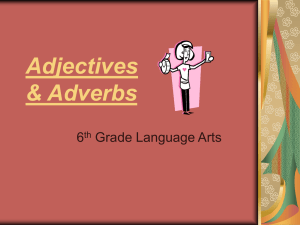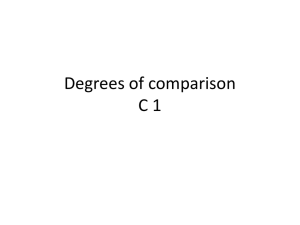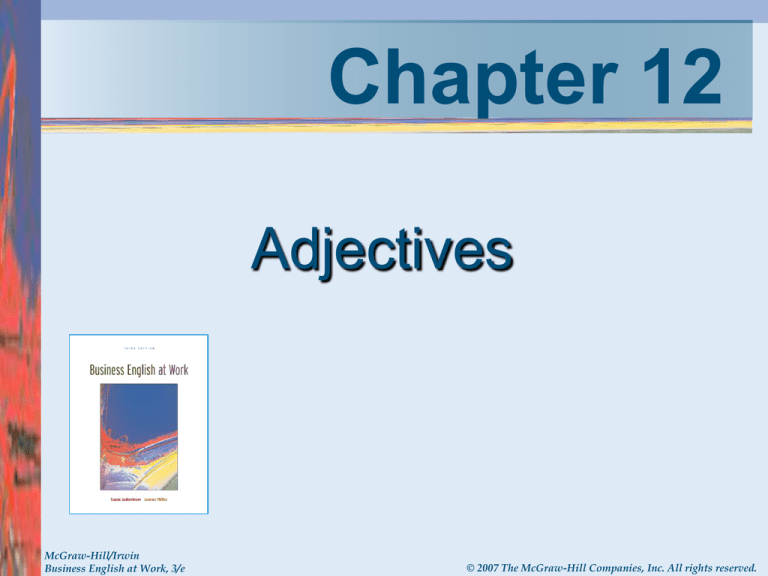
Chapter 12
Adjectives
McGraw-Hill/Irwin
Business English at Work, 3/e
© 2007 The McGraw-Hill Companies, Inc. All rights reserved.
Objectives
Identify the function of an adjective in a
sentence
Identify limiting, descriptive, possessive,
proper, and demonstrative adjectives in
sentences.
Use the articles a, an, and the correctly.
Hyphenate compound adjectives when
appropriate.
PP 12-1a
Objectives
Use the positive, comparative, and
superlative degrees of adjectives correctly.
Identify nouns modified by adjectives,
adjective phrases, and adjective clauses.
Determine the correct usage of commonly
misused adjectives.
PP 12-1b
Adjectives
An adjective is a word that modifies
(describes) a noun or a pronoun.
Several adjectives often appear in one
sentence.
More than one adjective may describe the
same noun or pronoun.
PP 12-2a
Adjectives
l
An adjective answers these questions:
What kind? green, old, round, strong
Which one? this, that, these, those
How many? two, few, 300, two-thirds, all, some
Whose? hers, Maria’s, companies’
PP 12-2b
Limiting Adjectives
Indicate how many.
May be numbers or words.
We must wait six weeks for the new chairs.
Lisa charges a $200 consulting fee.
PP 12-3
Descriptive Adjectives
Before Nouns
Answer the question What kind?
Usually precede nouns.
Are placed as closely as possible to the noun
or pronoun that they modify.
We request sealed bids for the workstation
estimates.
Back disorders may result from poor posture.
PP 12-4
Descriptive Adjectives
After Linking Verbs
Modify nouns or pronouns used as subjects.
Act as complements (predicate adjectives).
Usually follow linking verbs.
Proper office lighting is important.
The noise in this office seems excessive.
PP 12-5
Possessive Adjectives
Possessive pronouns such as my, her, his,
your, its, our function as adjectives. Possessive
nouns such as Jon’s or the company’s function
as possessive adjectives also.
Modify a noun or a pronoun.
Answer the question Whose?
You should use a keyboard that meets your
needs.
Richard’s degree is in marketing.
PP 12-6
Proper Adjectives
Proper adjectives are proper nouns or words derived
from proper nouns that function as adjectives. They
answer the question Which?
Capitalize most proper adjectives as you would proper
nouns.
We selected the Italian desk lamps.
Do not capitalize proper adjectives when they lose their
connections with the proper nouns from which they were
derived.
Shelly recommends a light blue venetian blind.
PP 12-7
Demonstrative Adjectives
The four demonstrative adjectives that modify
nouns are this, that, these, those. These
adjectives answer the question Which one? or
Which ones?
Use this or that with singular nouns.
Use these or those with plural nouns.
PP 12-8a
Demonstrative Adjectives
continued
Examples—
We recommend this computer monitor for
employees with vision problems.
We will have difficulty complying with that safety
regulation.
Many of these injuries are unnecessary.
Do those keyboards reduce wrist discomfort?
PP 12-8b
Guidelines for Using A or An
The initial sound (not the first letter) of the word
that follows an article determines whether you
will use a or an.
Use a before words beginning with a consonant sound.
a chair
a desk
a telephone
Use a before words beginning with the long sound of u.
a university a union
a uniform
PP 12-9a
Guidelines for Using A or An
continued
Use an before words beginning with the vowel sounds
a, e, i, o, and the short sound of u.
an asset
an unfortunate accident
an outcome
an estimate
Use an before words beginning with silent h.
an honest sales staff
an honor
an hour ago
PP 12-9b
The Article The
Use with singular or plural nouns.
Place before any other adjective when two or
more adjectives precede a noun.
Take short rest breaks throughout the day.
The indoor air quality of the building is excellent.
The most well-known category of CTD is carpal
tunnel syndrome.
PP 12-10
Repetition of Articles
Repeat an article before each noun when two
persons, places, or things are involved.
The manager and the supervisor approved the
new office design.
Do not repeat an article when only one
person, place, or thing is intended.
The manager recommended that the reception
area and waiting room be redesigned.
PP 12-11
Compound Adjectives—Hyphenated
Before and After Nouns
Some compound adjective combinations use
hyphens when appearing before or after nouns or
in other locations in a sentence.
This work-related injury could have been
prevented.
This office was described to me as fastpaced.
PP 12-12
Compound Adjectives—Hyphenated
Only Before Nouns
Some compound adjective combinations use a
hyphen when appearing before a noun.
This well-known furniture company is the one that
we selected.
When these combinations appear in other
locations in a sentence, they do not require
hyphens.
We selected this furniture company because it is
well known.
PP 12-13
Common Compound Adjectives
Do not use a hyphen when an adjective
plus a noun combination is widely
recognized as a concept or institution.
Our real estate agent recommended moving
to a new location.
Most of our positions require more than a
high school education.
To avoid wrist injury, learn the keystroke
combinations for your word processing
program.
PP 12-14
Nouns with Numbers
Use a hyphen to connect a number (words or
figures) and a noun to form a compound adjective
before a noun.
a 4-foot workstation
a 15-pound object
Do not use a hyphen when the expression
consisting of a number and noun follows the noun.
a workstation that is 4 feet
an object that is 15 pounds
PP 12-15
Numerical Compound Adjectives
Use hyphens in the numbers between 21 and
99 when the numbers are written as words.
Eighty-two out of one hundred adults will suffer
back problems at some point in their lives.
Our note to the bank is for Thirty-five Thousand
Five Hundred Thirty-three Dollars ($35,533).
PP 12-16
Series of Compound Adjectives
Use a hyphen in a series of compound
adjectives even though the base noun does
not follow each adjective.
Are you able to lift 15-, 20-, or 30-pound
objects?
We had an opportunity to choose 4-, 6-, or 8foot workstations.
PP 12-17
“Self” Words
Use a hyphen when self is connected to
another word to form a compound adjective.
self-confidence
self-reliant
self-fulfilling
self-worth
PP 12-18
Positive Degree
Use the positive degree as the base form of
the adjective to describe one person, place,
thing, quality, idea, activity, or one group of
things.
bright color
quiet printer
tall building
high bid
This turquoise fabric is a bright color.
Franklin Office Furniture submitted a high bid on
the computer chairs.
PP 12-19
Comparative Degree
Use the comparative degree to compare two
people, places, ideas, qualities, activities, or
things.
brighter color
quieter printer
taller building
higher bid
This turquoise fabric is a brighter color than the
gray fabric.
Franklin Office Furniture submitted a higher bid
on the computer chairs than Rincon Furniture.
PP 12-20
Superlative Degree
Use the superlative degree to compare more
than two persons, places, ideas, qualities,
activities, or things.
brightest color
quietest printer
tallest building
highest bid
This turquoise fabric is the brightest color of all
of the fabric samples.
Franklin Office Furniture submitted the highest
bid of all the vendors.
PP 12-21
Guidelines for One-Syllable
Adjectives
l
Add er to the positive form for its
comparative degree.
cool
tall
old
safe
high
clean
+
+
+
+
+
+
er
er
er
er
er
er
=
=
=
=
=
=
cooler
taller
older
safer
higher
cleaner
PP 12-22a
Guidelines for One-Syllable
Adjectives
continued
l
Add est to the positive form for its
superlative degree.
cool
tall
old
safe
high
clean
+
+
+
+
+
+
est
est
est
est
est
est
=
=
=
=
=
=
coolest
tallest
oldest
safest
highest
cleanest
PP 12-22b
Guidelines for Two-Syllable
Adjectives
Add er or add more or less to the positive
form for its comparative degree.
Add est or add most or least to the positive
form for its superlative degree.
Positive
narrow
Comparative
Superlative
quiet
narrower or more
narrow
quieter or more quiet
narrowest or most
narrow
quietest or most quiet
simple
simpler
simplest
PP 12-23
Guidelines for Three-Syllable
Adjectives
Add the word more or less before the positive
form for its comparative degree.
Add the word most or least before the
positive form for its superlative degree.
PP 12-24a
Guidelines for Three-Syllable
Adjectives
continued
Positive
Comparative
Superlative
attractive
more attractive
most attractive
essential
more essential
most essential
efficient
complicated
less efficient
less complicated
least efficient
least complicated
PP 12-24b
Words Ending in y
l
Change the y to i and add er or est to form the
comparative and superlative degrees.
Positive
Comparative
Superlative
friendly
friendlier
friendliest
busy
busier
busiest
heavy
heavier
heaviest
happy
happier
happiest
PP 12-25
Special Forms
Some irregular adjectives change in their
comparative and superlative forms.
Positive
good
bad
little
many
much
Comparative
better
worse
less, lesser
more
more
Superlative
best
worst
littlest, least
most
most
PP 12-26
Absolute Adjectives
Already express the highest degree.
circular
horizontal
straight
complete
ideal
supreme
correct
instantaneous
unanimous
dead
perfect
unique
empty
single
vertical
PP 12-27
Adjective Clauses
Use who, whose, which, and that to connect to
the noun or pronoun that is modified.
Place an adjective clause immediately after the
noun that is described.
Use commas to set aside the clause when it does
not add to the meaning of the sentence
(nonrestrictive clause). Do not use commas when
the clause is necessary to the meaning of the
sentence (restrictive).
PP 12-28a
Adjective Clauses
continued
Example of a nonrestrictive clause
The firm’s corporate office, which is in Florida,
compiled statistics on workplace injuries.
Examples of restrictive clauses
Workers who must repeat the same motion
throughout the day are most likely to develop RSIs.
Several Web sites that I discovered provide excellent
information about ergonomics.
PP 12-28b
Adjective Phrases
Function as modifiers of nouns or pronouns
and may be infinitive phrases, participial
phrases, or prepositional phrases.
To avoid pain in my wrists, I wear a wrist
support.
Having no break from working on the
computer, I noticed that my eyes were dry.
The wireless mouse from Computer Town was
highly recommended.
PP 12-29
Fewer/Less
Use fewer with plural nouns. Fewer refers
to number.
Using computer function keys causes fewer
hand injuries.
Treehorn Books had fewer complaints after
lowering the bookshelves.
PP 12-30a
Fewer/Less
continued
Use less with singular nouns when you
refer to degree or amount.
Simple ergonomic changes cost less money
to implement than you might imagine.
Use less than before nouns that express
money, percentages, time, distance, and
measurements.
We planned to spend less than $500 for a
new chair.
PP 12-30b
Farther/Further
Use farther to refer to physical distance.
Use further to mean additional.
The printer is farther from my workstation
than I like.
The new office supply store is farther from
our office than we expected.
Poor indoor air quality causes further
problems to people with asthma.
Jane will provide further information about
the workstation at the next meeting.
PP 12-31
Latter/Later/Last/Latest
Use latter to refer to the second of two
persons, places, or things mentioned.
Use later to refer to time.
Use last to refer to whatever follows
everything else in a series.
Use latest to refer to time (as in most recent).
PP 12-32a
Latter/Later/Last/Latest
continued
Examples
The latter plan for the reception area is more
comfortable for visitors than the others that were
submitted.
The latest set of statistics about work-related
injuries just arrived.
We ordered new computer keyboards last year.
The later time for the planning meeting was not
suitable for me.
PP 12-32b


